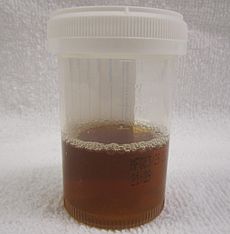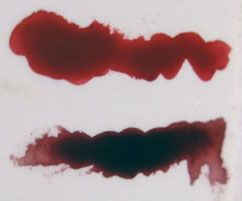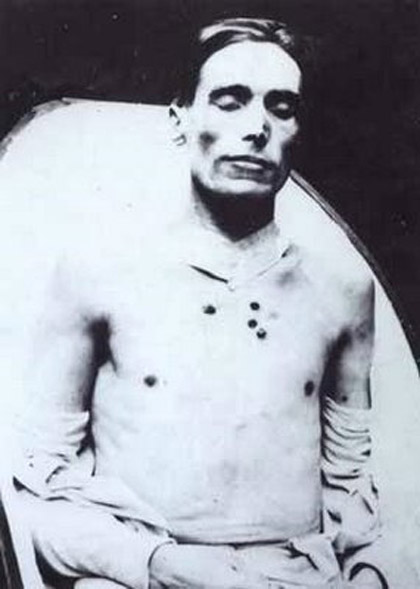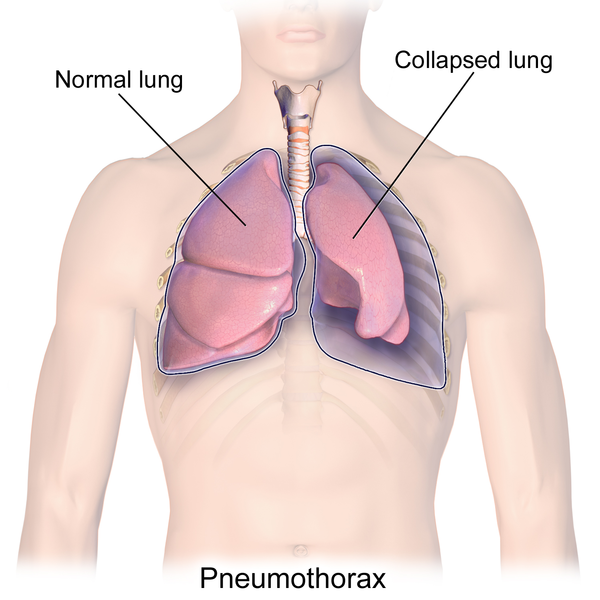

Historical Tales | News | Vampires | Zombies | Werewolves
Virtual Academy | Weapons | Links | Forum
 |
 |
Historical Tales | News | Vampires | Zombies | Werewolves Virtual Academy | Weapons | Links | Forum |
Return to Part IV
Muscular & Skeletal System
Vocal Folds: During the coma, structural changes in the larynx cause vampires to speak more quietly. As a result, their voices crack when they try to shout, which is why they prefer to hiss, expelling air through their clenched mouths. Over the years as their mucous membranes thin and they lose elasticity in their vocal cords, a male vampire will develop a higher, thinner-sounding voice, while a female's voice will deepen. Contrary to some fiction, vampires do not growl like wolves or roar like lions, but they can emit high-pitched shrieks if they scream loud enough.
 |
|
X-ray of a vampire's curved spine |
Skeletal System: Osteoblast production causes a vampire's entire skeleton to harden and thicken, both during the coma and after each feeding. This makes their bones much more efficient at absorbing shock from high-impact forces such as jumping, falling, blunt trauma, and even bullets. As a vampire loses its fat and water stores, its overall height will shrink down by 1 to 3 inches, due to a gradual contraction of the ligaments between the joints and spinal vertebrae. The former symptom results in frequent crackling and popping of the joints, while the latter causes the spine to curve into a hunchback (a condition known as kyphosis). The taller a vampire is, the more height it will lose, since a longer spine will curve more than a shorter one.
Respiration: Because vampires don't produce much body heat, oxygen use is cut down by roughly two-thirds. Along with the fact they can absorb more oxygen with each breath, this allows them to go significantly longer without drowning or suffocating. For example, while an average human takes 12 to 20 breaths per minute (at rest), a vampire takes only 3 to 7.
 |
| What vampires are most known for |
Diet: As you may know, the average human body contains 5 to 6 liters of blood, but a vampire's stomach can only hold about 1.5 liters. While a pack of vampires has no problem draining a single victim, a lone vampire is forced to rely on a series of smaller feedings over a period of several hours. This is where its narcotic-like saliva comes in, as it keeps the victim sedated while the vampire goes back and forth between feeding and draining its bladder. Similar to humans with solid food, a vampire can go more than a month without drinking blood; but they're also different in that they can go equally as long without any kind of water, while humans can only go about a week.
 |
| A bottle of vampiric urine |
Fat: Vampires experience a noticeable degree of weight loss during the coma, since they require a tangible amount of fuel to change their body structure—hence why they're starving by the time they wake up. Vampires who are overweight will shed the extra pounds over a matter of weeks, thanks to their liquid diet and highly active lifestyle. Despite the rapid weight loss, hanging skin is never a permanent problem for a vampire, since victims who are obese/old enough to cause irreversible skin stretching never survive vampiric comas anyway. Needless to say, vampirism is not a recommended weight loss remedy.
 |
| Photo Credit: Stu Spivack |
Dietary Restrictions: Aside from the fact that vampires can't consume much else other than blood, they're also limited to mostly human blood. While they can live several weeks on non-human mammals, such a diet does not supply all the nutrients essential for their survival. Non-mammals, such as birds and lizards, will only do for a few weeks. Vampire blood is by far the worst substitute. In 1928, the Goessman Institute supplied a total of 20 starving vampires with a plentiful diet of vampire blood. Although sated at first, they became lethargic and disoriented after only 3 days. Within 10 days, all 20 vampires were dead. To put it simply: vampires must drink the blood of humans, or die. It is this simple equation that drives their powerful survival instinct. Not even blood bags will do for more than a few months, as vampires absolutely require that thrill of hunting—as well as sufficient amounts of fear hormones from their victims—to effectively metabolize each meal. This shouldn't come as a surprise, considering that vampires have spent their entire evolution feeding directly on living humans against their will.
Nutrition: For more information on how vampires utilize human blood, see the CDC article on vampire nutrition.
 |
|
Human arterial blood (top) compared with that of a vampire |
Blood: Known as ichor (pr. ik-er), vampire blood takes on a much darker color due to an increase in iron, bile and other toxins that escape from the liver and spleen. This ichor darkens even further over the next three to four months as a vampire feeds and replaces its blood supply. Although vampire blood may appear brown or black, arterial blood is actually a dark rusty red when diluted. The extra iron not only darkens the blood, but makes it clot faster as well. And although a vampire's oxygen intake is lowered by its slowed metabolism, the blood oxygen itself actually increases thanks to the added iron storage in the new hemoglobin and erythrocytes.
Heart: Vampire blood is pumped via the contraction of skeletal muscle rather than the heart, which eventually atrophies from disuse. This forces high-pressure venous blood toward the heart, which constantly swells and drains as low-pressure arterial blood is pushed away from it. While at rest, involuntary spasms known as fasciculations take place in the limbs, and emanate from the furthest extremities inward—similar to the wave-like peristalsis of the GI tract. Since it affects the muscles required for movement, slight tremors are common, but only when the muscles aren't in use. Voluntary diaphragm and abdominal action also aid blood flow to the brain. Along with their claws, hand tremors can be a dead giveaway for a disguised vampire, so they'll try to keep them out of view while in public.
 |
| Humans also pump blood this way, though it's strictly voluntary. |
| Some humans experience fasciculations as well. |
Adrenaline: This "emergency hormone," produced by the adrenal glands, is released in consistently large amounts in vampire blood during "fight-or-flight" situations. This quickly raises a vampire's sluggish metabolism by increasing blood flow, dilating air passages and accelerating the production of clotting factors. Along with changes in muscle, bone and connective tissue, this ability to release adrenaline only adds to a vampire's extraordinary power.
Disease Resistance: In addition to natural antibiotics that slow the growth of harmful bacteria, most viruses are simply incompatible with vampiric cells thanks to changes in their surface proteins. For reasons tied closely with their lack of aging (as detailed later), there has also never been a reported case of a vampire having cancer; in fact, vampires who had cancer when they were infected lose all traces of the disease within a few months after transformation. This resistance to disease is not surprising, considering that the HVV virus can infect every tissue in the body without causing cancer or fatal bacterial infections.
 |
|
A vampire after taking four bullets to the chest, resulting in only about 20% blood loss. Date: November, 1815. |
Intestinal Injuries: While untreated stabbings and gunshot wounds to the stomach and intestines usually result in agonizing and fatal infections in humans and other vertebrates, it's only a temporary (though still painful) inconvenience for a vampire. The surrounding organs and abdominal wall are coated with a thick layer of antibacterial mucus which protects the body in the event of an intestinal breach—along with the fact that a vampire's liquid diet requires less gut bacteria. In addition, if any part of the GI tract has been severed, it will quickly mend back together over the course of several days, using the same process as a broken bone or severed tendon. The vampire will not be able to feed during this time (due to vomiting and possible diarrhea), and will usually go dormant until it is fully healed.
 |
Medical Applications: Along with their profound resistance to disease, there was considerable research into vampiric circulation and possible applications for human medicine. One such breakthrough was the ventricular assist device, which allows humans to live without a heartbeat. There's also a physical exercise based on this method of circulation, which involves tensing and relaxing one's leg and arm nodes while at rest. Not only does it strengthen the muscles, it also improves venous circulation and nerve control. As for faster clotting abilities, the problem of vessel blockage formation has yet to be solved.
Medical Complications: Depending on the particular model, a vampire wearing a pacemaker upon transformation may experience agonizing pain from the constant shocking of their paralyzed heart, until the device runs out of power. However, this only applies to the older models: the newer ones only shock the heart a certain number of times before deactivating. Victims bearing transplanted organs will always die, even if they're vaccinated before the coma. This is due to their chemically-suppressed immune system being too weak to combat the virus, which then strengthens the immune system enough to attack the foreign organ, which in-turn kills the host. Pregnant women who are bitten will always miscarry, and can even die if left unvaccinated (depending on how developed the fetus is). In fact, there were many cases of desperate women seeking out vampires and their blood to abort their pregnancies, starting from 1950 when the vaccine was created up until 1973 when Roe v. Wade was decided.